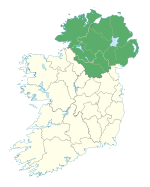Slieve Croob
This article needs additional citations for verification. (April 2008) |
| Slieve Croob | |
|---|---|
| Sliabh Crúibe | |
 | |
| Highest point | |
| Elevation | 534 m (1,752 ft) |
| Prominence | 439 m (1,440 ft) |
| Listing | List of Marilyns in Northern Ireland |
| Naming | |
| English translation | mountain of the hoof |
| Language of name | Irish |
| Geography | |
| Location | County Down, Northern Ireland |
| Parent range | Dromara Hills |
| OSI/OSNI grid | J318453 |
Slieve Croob (from Irish Sliabh Crúibe 'mountain of the hoof')[1] is the tallest of a group of peaks in the middle of County Down, Northern Ireland. These peaks lie north of the Mourne Mountains, between the village of Dromara and the town of Castlewellan. Slieve Croob has been designated an Area of Outstanding Natural Beauty. It is the source of the River Lagan, which starts as a spring and runs from here, through Dromara, Dromore, County Down, Lisburn and Belfast, where it enters Belfast Lough.
Folklore
Folklore tells that 12 kings are buried at the hilltop and each year it is traditional to climb Slieve Croob on the first Sunday in August (known as Cairn Sunday or Blaeburry Sunday) and carry with you a stone to help bury the kings. In recent times there is traditional Irish music played at the top of the Mountain on this date.
Places of interest
- Legannany Dolmen is situated nine miles southeast of Banbridge and three miles north of Castlewellan, on the slopes of Slieve Croob near the village of Leitrim,[2]
Communications
A number of communications relay stations are located on the summit of Slieve Croob. They include communications towers for British Telecom, Vodafone, police & emergency services, and the government.
Gallery
-
Slieve Croob from the west, covered with patches of snow
-
Cratlieve (left), Slieve Croob (middle) and Slievenisky (right) from the south
-
Communications towers on Slieve Croob
References
- ^ Mills, A. D. (2003). A Dictionary of British Place-Names. Oxford University Press. Retrieved 2009-01-20.
- ^ "Banbridge". Travel Now. Retrieved 2007-12-11.






